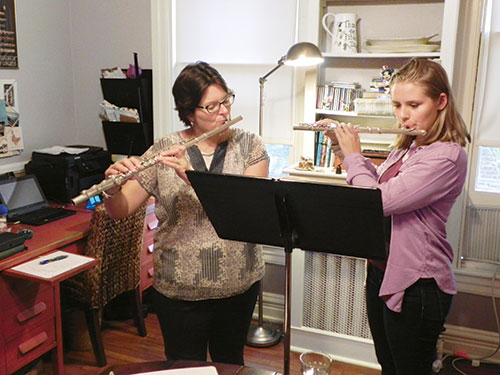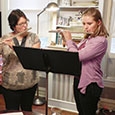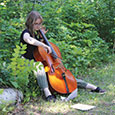
In the 1990s, I was a young teacher working on the West Coast in a town where many of the band directors had resorted to teaching students by rote. My students frequently arrived for a lesson saying, “I couldn’t practice this. I don’t know how it goes.” I ranted and railed about this to anyone who would listen, but to no avail. I was the crazy flute teacher who wanted her students to be musically literate.
I began to use duets as carrots saying, “If you play these four scales correctly, we will play a fun duet together.” One day, a very shy prospective student arrived and was reluctant to do more than assemble her flute and sit on my couch. I finally coaxed her off the couch to play a duet and realized that fun duets could be a powerful tool.
I began starting every lesson with duets. I used easy books, like Learn to Play Flute Duets by William Eisenhauer. This book has both flute parts on the same page, vertically aligned, which makes it easier for inexperienced sightreaders to find their spot in the music when they get lost. Starting lessons with duets had numerous benefits, including some that I did not expect. My students, who were mostly in middle and high school, often came in wanting to debrief me about their school day or week. While these conversations were a helpful way to get to know students and allowed them to purge their emotions before lessons, they often took up too much valuable lesson time. Starting with a duet gave them something to focus on immediately. It became a cue that said, The Lesson Is Starting Now. Since starting lessons with duets, my students have all been able to focus on the lesson material more immediately and are less easily distracted.
It also gives me a moment in between lessons. While an incoming student is looking over the duet we are about to sightread, I can finalize notes from the last lesson, check in with a parent picking up the previous student, or use the restroom.
Another benefit is that my students quickly became readers. When I began this practice, my students were initially skeptical. One or two even cried at the prospect of sightreading a duet, until I showed them how easy the material was. It was still hard for many of them at first. I had to go through the duets phrase by phrase and sometimes measure by measure, demonstrating how to count the rhythms. Sometimes, I even had to explain how to read the notes. I would often have to play the student’s line with them to get them started, and then sneak down to my line. Their expressions as they realized they were playing a duet reminded me of a child suddenly noticing that her parents are not holding the bike up anymore, and that she is pedaling forward on her own.
In fact, during that first year, there was a brief period right before a local audition that many of my students were preparing to take, when I attempted to skip the sightreading duet. The same students who had complained and cried initially were now asking me at the end of their lessons, “Why didn’t we play a duet?”
Gently, over the course of a few months, these students became better and better readers. (Their rote-teaching band directors wondered why they were learning their music so fast all of a sudden.) I increased the difficulty, and some students were promoted to Marcel Moyse’s Album of 30 Duets. Students who were only used to playing in the few flat keys that most band repertoire is written in gradually became more comfortable in sharp keys.
My students’ tones also improved. They were playing with me, and I was encouraging them to match my sound and to play in tune with me. While I do not want students who only sound like me, in the days before YouTube and constant internet access, this was a great listening and tone development exercise. They were playing music that was canonic or imitative, and often had to strive to match my sound, articulation, dynamic level, and eventually vibrato. This experience stretched and molded them as musicians.
My students’ confidence in their abilities as sightreaders also increased. As a student, I remember having the moment of realization that there was really no piece of music that was too difficult for me to play, provided I put in the required amount of practice time. Becoming a fluent reader helps students come to that understanding.
Another benefit is that when a teacher sightreads frequently with students, they can ask questions that help reinforce good practice techniques. For example, I might ask, What parts of this would you practice at home if you were preparing it for a performance? or How would you go about learning this? Students who are fluent sightreaders see the possibilities and challenges in learning new music as an appetizing prospect, not a mountain to climb.
My newly sightreading students also surprised me in that they began playing chamber music with their peers. Now that they were musically literate, they could explore new music without me or their band director spoon-feeding it to them. The world of music was open and available to them, and it was wonderful to watch them explore new repertoire possibilities.
I do not limit sightreading to duets. When students are preparing for auditions that require sightreading, I have them read unaccompanied pieces for solo flute. Mike Mower’s The Modern Flute Player contains fun solo flute pieces that start simply, with no subdivision greater than the eighth note, and get progressively more difficult with syncopation, jazz, and rock influences throughout. My students love this book so much, with its catchy titles like Psychopation and Pentamental Journey, that they forget they are missing out on duet time.
When students prepare to sightread something for the first time, I have them answer the following questions:
• Who is the composer and what do we know about her or him? This is a great opportunity to teach students about various periods and styles, and about the development of our modern flute and other instruments.
• What is the key signature? Students who play only in band will initially balk at sharp keys and flat key signatures with more than three flats. Eventually, they will grow more comfortable in these unfamiliar keys, and their experiences sightreading in these keys will reinforce the need to learn these scales.
• What is the time signature? I do not shy away from compound or asymmetrical meters. It has been my experience that introducing these meters early normalizes them. Students are less afraid to play in these meters if they are introduced as part of their early repertoire, and will become fluent in the rhythmic patterns unique to these keys.
• What is the tempo or style marking? Often, if there is no specific metronome marking, a new student will ask me to give the tempo. I help them to find their own tempo by looking at difficult measures in the piece and experimenting with how different tempos affect their interpretation.
• What is the road map? Encourage students to look ahead for repeats and markings like Da capo, and Dal segno. Discuss where to go and what to do. This is an opportunity to discuss form and certain standard musical practices, such as not taking repeats on a Da capo.
• What is the dynamic scheme? Looking ahead at dynamics can help determine the overall shape of the piece. Often, teachers advise students to read without the dynamics. I ask students to attempt dynamics on their first play-through if possible. Dynamics are as much a part of the musical expression as the notes. As an adjudicator, I have heard 100 flutists play the same excerpt on a given day. The top spot always goes to the student who plays with dynamics and expression.
• Are there any markings or terms in this piece you do not know or understand? With instant access to information, there is no excuse for a student, or a professional for that matter, to play a piece without understanding all of the terms and articulation markings. That said, I often ask students to make educated guesses regarding terms. Most students, for instance, immediately understand the Italian term accelerando – to gradually increase the tempo. Many bakeries and cafes have the word dolce in their names, and it is easy to guess that marcato means marked. Relating terms to words and experiences students are already familiar with makes it easier for them to remember the meanings of these terms.
• What is coming later in the piece? I also remind them to be sure to scan ahead for changes in tempo, style, key, or meter.
After looking at all these parameters, I tell students that the most important rule in sightreading is never stop – even if you make a mistake. As Michel Debost has said, “casualties are counted after the battle.” Put the mistakes out of your head for the time being and keep reading forward.






